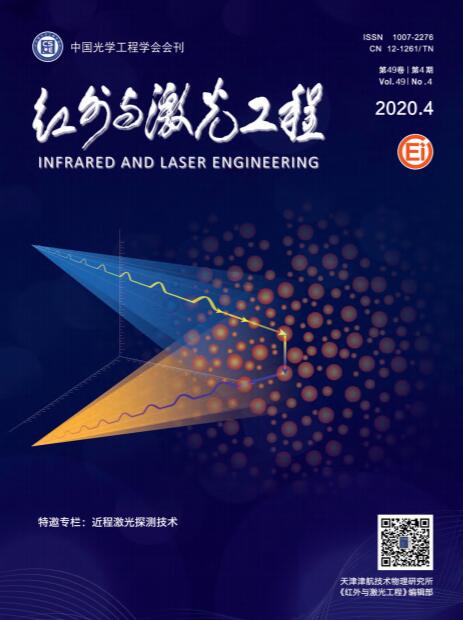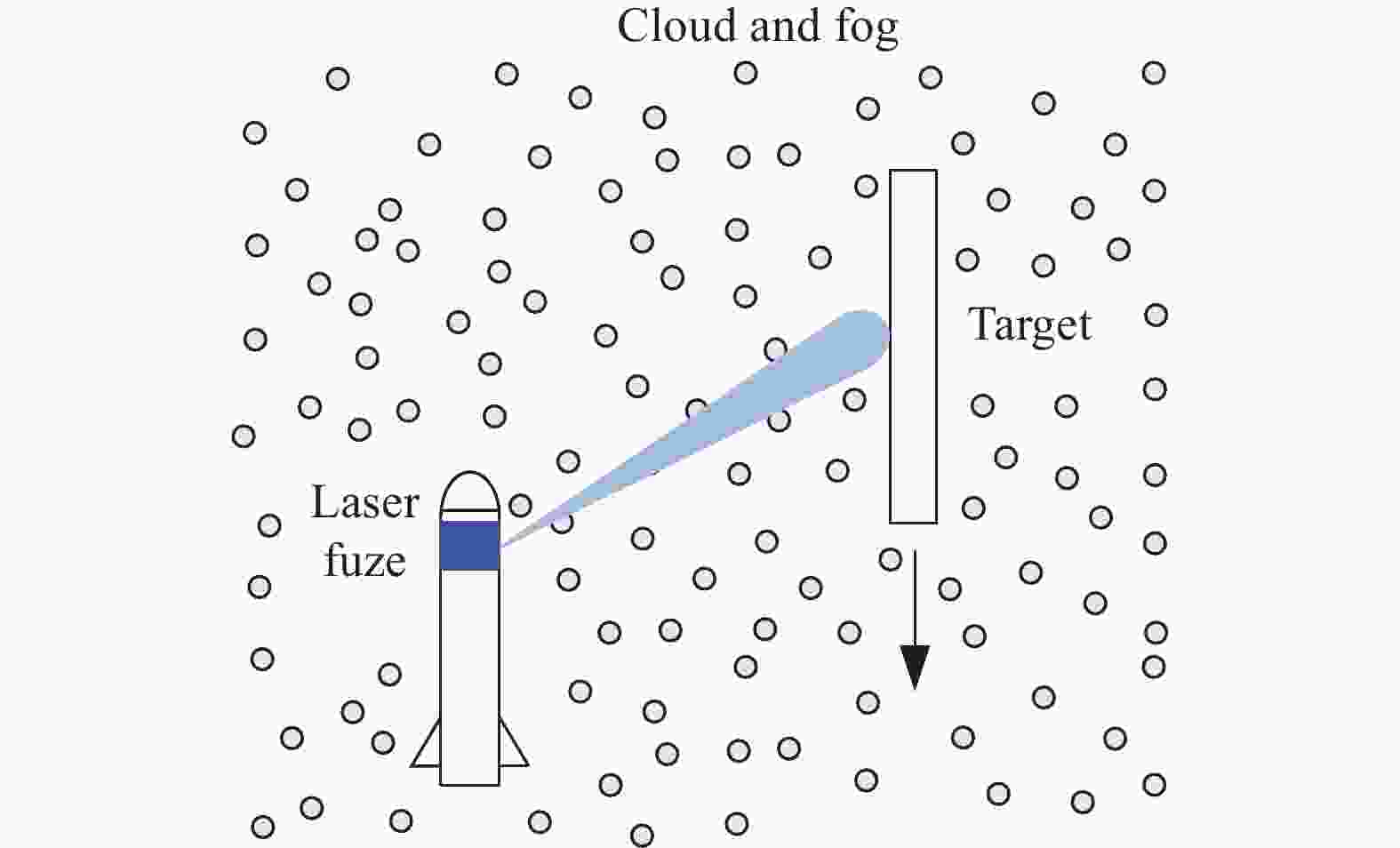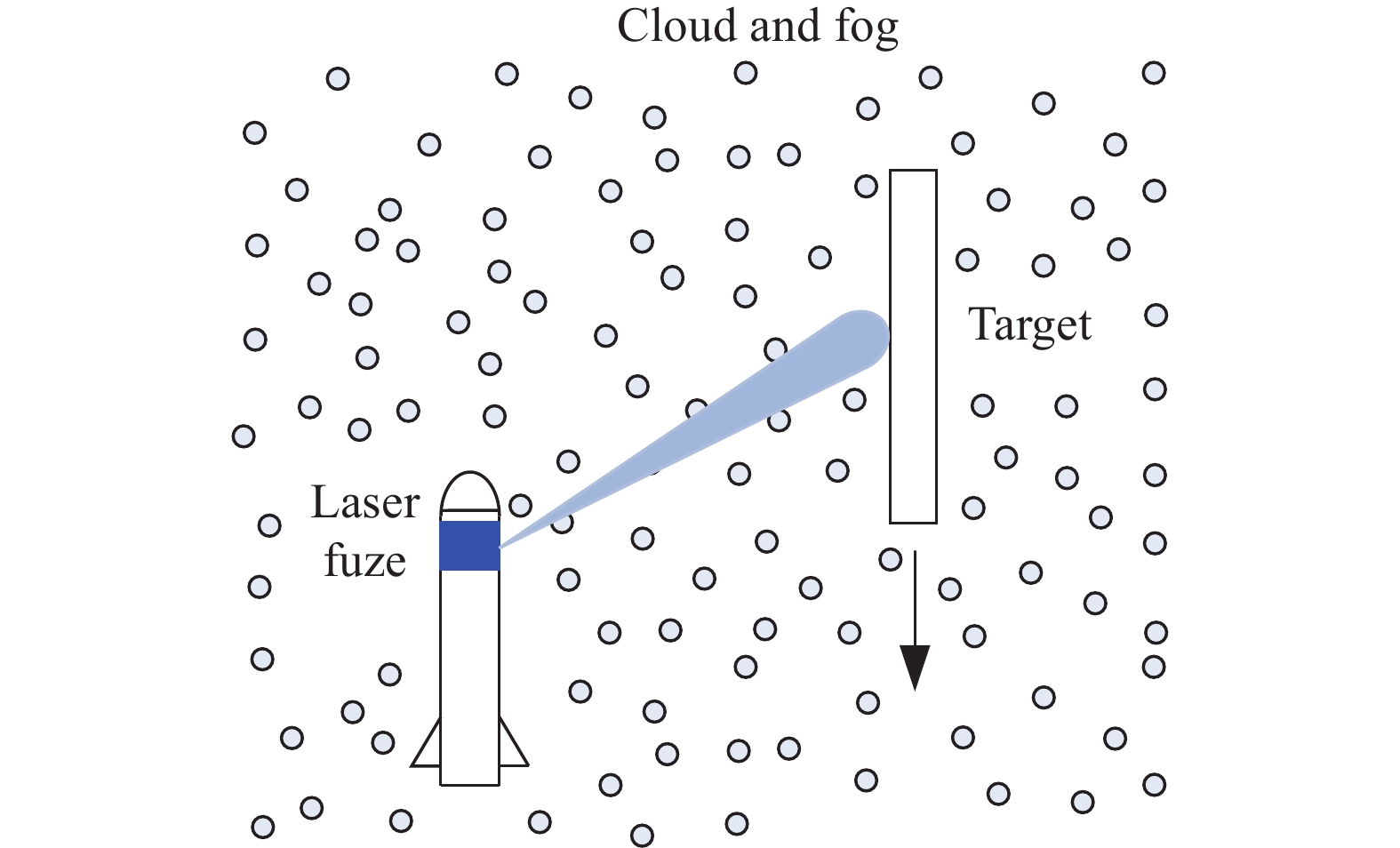-
如何提高抗云雾干扰能力,降低在云雾环境中的虚警,是对空武器平率和漏警率台激光引信亟待解决的一大难题[1]。目前已有多种技术方案尝试解决这一难题,如双色激光探测技术利用云雾对不同波长激光散射特性的差异来识别干扰[2-3]、复合体制探测技术通过引入对云雾干扰不敏感的探测体制来提高抗干扰能力[4]、超窄脉冲技术通过降低云雾后向散射强度来消弱干扰[5]、相干探测技术利用速度特性进行目标与干扰的识别[6]等。
上述技术方案中,相干激光引信技术是基于激光相干探测原理,将目标反射回来的信号光和由本振激光器输出的本振光进行相干混频,获取回波信号的振幅、频率和相位等信息,实现对目标的探测与识别[6]。董骁[7]建立仿真模型,数值模拟了4种典型气溶胶对相干激光雷达的回波特性。刘波[8]搭建测试平台开展了相干激光雷达测速试验,分析了相干激光雷达的测速精度,并提出了多项优化方法。上述研究的对象均为远距离探测的激光雷达,其结论不一定适用于近距探测的激光引信。
因此,建立仿真模型,开展相干激光引信在云雾干扰环境下的探测回波特性研究,分析其抗云雾干扰性能。
-
相干激光引信原理框图如图1所示。激光器发射的激光通过分束器件分为两路:一路作为探测光,通过发射光学系统发射到外界中探测目标;另一路则作为本振光,与回波光进行相干混频。探测光回波通过接收光学系统返回引信内部,与本振光合束后送入光电探测器中,利用光电探测器的平方律探测特性得到包含目标信息的相干差频信号,并由信号处理系统解算出目标的距离、速度等信息。
根据相干激光引信的工作原理,建立相干激光引信探测模型,具体包括激光发射模型、激光在云雾中的传输模型、目标散射模型和激光接收模型。
-
相干激光引信中,激光器发射的激光在时域上为固定幅度连续信号,在频域上为三角波信号,表达式为:
式中:
${f_{\max }}$ 为频域信号的上限值;${f_{\min }}$ 为频域信号的下限值;$T$ 为频域信号周期。激光器发射的激光被分为探测光与本振光,其功率分别为:
式中:
${P_{RF}}$ 为探测光功率;${P_{LO}}$ 为本振光功率;${P_{trans}}$ 为激光器发射的功率;$R$ 为探测光的分光比。探测光通过光学系统发射到外界环境中进行探测,光子发射位置为[9]:
式中:
${\omega _0}$ 为激光束腰半径。光子发射方向为[10]:式中:
${\theta _t}$ 为光子发射方向天顶角;${\varphi _t}$ 为光子发射方向方位角。 -
在云雾中,根据粒子粒径分布抽样确定碰撞粒子的粒径。其中,云雾粒径分布函数为[11]:
式中:r为云雾粒径;
$a$ 、$b$ ,$\alpha $ 和$\beta $ 为分布参数。光子与粒子碰撞后的能量变为[12]:
式中:
${E_{bs}}$ 为散射前的光子能量;${Q_{sca}}$ 为粒子的散射系数;${Q_{ext}}$ 为粒子的消光系数,表达式为[13]:式中:
$x$ 为粒子尺寸参数;${a_n}$ 、${b_n}$ 为Mie散射系数。光子与云雾粒子碰撞散射后的移动方向变为[14]:
当
$\left| {{u_{zs}}} \right| > 0.99 999$ 时,公式(9)调整为:式中:
${\varphi _{sca}}$ 为散射方位角;${\theta _{sca}}$ 为散射天顶角,根据Mie散射相函数抽样确定[15]:式中:
${S_1}(\theta )$ 、${S_2}(\theta )$ 为散射振幅函数。与粒子碰撞后的光子沿着新方向继续移动,移动距离为[16]:
式中:
${\mu _t}$ 为云雾衰减系数。 -
当光子在移动过程中遭遇目标,会被目标散射从而改变方向和能量。平面目标对光子的散射方向为:
式中:
${\varphi _{ref}}$ 为散射方位角;${\theta _{ref}}$ 为散射天顶角。当目标为朗伯散射体时,${\varphi _{ref}}$ 为$\left[ {0,2\pi } \right]$ 区间上的均匀分布随机数,${\theta _{ref}}$ 根据目标在各方向的散射强度抽样确定,朗伯反射体沿各方向的散射强度为:目标散射后的光子能量变为:
式中:
${E_{br}}$ 为目标散射前的光子能量;${\eta _t}$ 为目标反射率。 -
若光子在散射后被引信接收,根据公式(16)计算光子的飞行时间,根据公式(17)计算光子的光频。
式中:
$L$ 为光子的飞行距离;$c$ 为光速。式中:
${f_{trans}}$ 为光子发射时的光频;${\rm{\lambda }}$ 为激光波长;$v$ 为散射体(目标或云雾)的移动速度;${\rm{\theta }}$ 为散射体移动方向与光子飞行方向之间的夹角。统计引信接收的全部光子的飞行时间和光频,得到回波光的时域信号和频域信号。将回波光与本振光进行相干混频,混频后的相干信号能量为:
式中:
${E_{echo}}$ 为回波光的能量;${E_{LO}}$ 为本振光的能量。相干信号的频率为:式中:
${f_{RF}}$ 为回波光的光频;${f_{LO}}$ 为回波光接收时的本振光光频。 -
在引信位于云雾内部的场景中,目标为一块反射率0.3的朗伯体平板,位于云雾内部,与引信相向飞行,飞行速度为340 m/s,脱靶距离为5 m;云雾粒径范围为0.1~50 μm,能见度分为10 、30 、50 和80 m四档,以20 m/s的速度与目标同向移动;引信以60°倾角(探测光束与弹体之间的夹角)发射波长为1 550 nm的激光对目标进行探测,激光束在子午方向和弧矢方向的发散角均为5 mrad,激光发射与接收共用一套光学系统,孔径为25.4 mm,子午方向和弧矢方向的接收视场角均为21 mrad。仿真主要参数值如表1所示,仿真场景如图2所示。
Simulation parameters Value Simulation parameters Value Dip angle of fuze/(°) 60 Laser wavelength/nm 1 550 Laser divergence angle/mrad 5 Receiving field angle/mrad 21 Visibility of cloud and fog/m 10, 30 50, 80 Optical lens diameter/mm 25.4 Particle diameter of cloud and fog/μm 0.1–50 Speed of cloud and fog/m•s–1 20 Complex index of refraction 1.317–8.55×10–5i Target distance/m 5 Target reflectivity 0.3 Target speed/m•s–1 340 Table 1. Main parameters of model when the fuze is located cloud and fog
当云雾能见度分别为10 、30 、50 和80 m时,相干激光引信接收到的回波信号的时域波形与频域波形如图3所示。观察图3中的时域波形,当云雾能见度为10 m时,目标回波完全被云雾回波淹没,回波信号无法反映引信周围的目标与环境状态;当云雾能见度依次增大至30 、50 和80 m时,目标回波逐渐增强,回波信号呈现出双波峰特征,但是考虑到体目标也可能产生此类回波,因此引信依然无法根据回波信号进行准确判断。再观察图3中的频域波形,四种能见度条件下的回波信号在频域上均出现了两个清晰的点频信号:第一个点频信号位于13 MHz处,是由云雾回波形成的;第二个点频信号位于219 MHz处,显然是由目标回波形成的;目标回波与云雾回波在频域上差异明显,极易分辨。上述结果表明,在低能见度环境和低信噪比条件下,相干激光引信可以利用频域特征准确识别出目标和云雾。
-
在引信位于云雾外部的场景中,云雾边界距离引信5 m,目标脱靶距离为10 m,其余状态与引信位于云雾内部时的场景相同。仿真场景如图4所示。
图5为四种云雾能见度条件下,相干激光引信位于云雾外部时回波信号的时域波形和频域波形。图5中的结果与图2相比,引信回波信号的时域波形在时刻、幅度等方面均发生了变化,而频域波形只有信号幅度出现了一些变化,频点位置未发生改变。上述结果表明,引信、目标和云雾之间的位置关系,不会影响相干激光引信对目标和云雾的准确识别。
-
探测角度是指引信发射的激光束与目标飞行方向之间的夹角,其对引信回波的频域特征具有重要影响。当目标飞行速度为340 m/s时,目标回波频移与与探测角度的关系如图6所示,图中阴影区域为云雾移动速度20 m/s时的云雾回波频移范围。观察图6,当探测角度为0°或180°,即探测光束与目标飞行方向平行时,目标回波的频移量最大,为438.7 MHz;当探测角度为90°,即探测光束与目标飞行方向垂直时,目标回波的频移量最小,为0 Hz。当探测角度在86.6°~93.4°这一狭窄区间时,目标回波的频移落入云雾回波频移范围(0~25.8 MHz)内,即目标回波与云雾回波可能在频域发生混叠,导致引信无法准确区分目标与云雾;而在其他区间内,目标回波的频移均超过了云雾回波频移最大值,即目标回波与云雾回波在频域上区分明显,引信可准确识别出目标。上述结果表明,在绝大部分探测角度下,相干激光引信可利用频域特征区分出目标与云雾。
-
文中建立相干激光引信在云雾中的探测模型,仿真研究了多种因素影响下相干激光引信在云雾干扰环境中探测回波的时域特性和频域特性研究结果表明:(1)相干激光引信的目标回波与云雾回波在频域上差异明显,引信可利用这一特征准确识别目标和云雾;(2)云雾能见度、探测位置和探测角度等因素对相干激光引信在云雾中探测性能的影响很小。文中研究成果验证了相干激光引信在云雾干扰下的优良探测性能。
Study on echo characteristics of coherent laser fuze in cloud and fog
doi: 10.3788/IRLA202049.0403006
- Received Date: 2020-01-02
- Rev Recd Date: 2020-02-20
- Publish Date: 2020-04-24
-
Key words:
- coherent laser fuze /
- cloud and fog /
- echo characteristics /
- simulation
Abstract: In order to analyze the performance of coherent laser fuze under cloud and fog interference, the detection model of coherent laser fuze in cloud and fog was created based on Mie scattering theory and Monte Carlo method. Through simulation, the echoes of coherent laser fuze were obtained in various scenes. The time-domain and frequency-domain characteristics of echoes were analyzed, as well as the influence of cloud and fog visibility, detection position, and detection angle on echoes. The results show that the coherent laser fuze can accurately identify the target by using the frequency-domain characteristics, and is not easily affected by factors such as cloud and fog visibility, detection position, and detection angle. The results demonstrate the excellent detection performance of coherent laser fuze in cloud and fog.

























































 DownLoad:
DownLoad:


